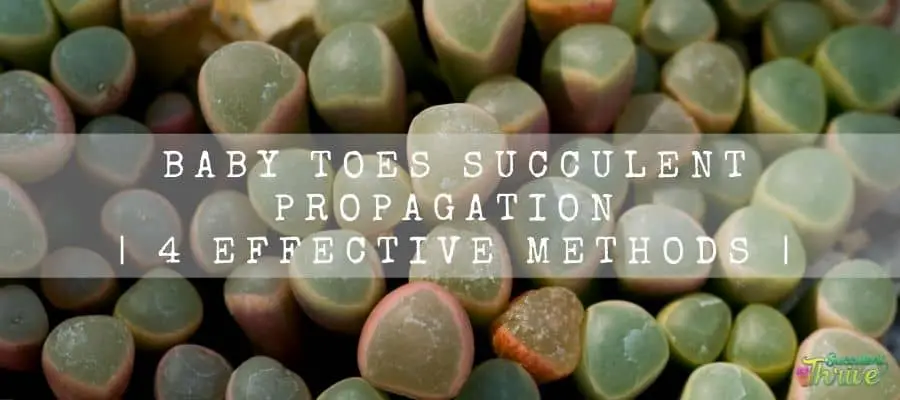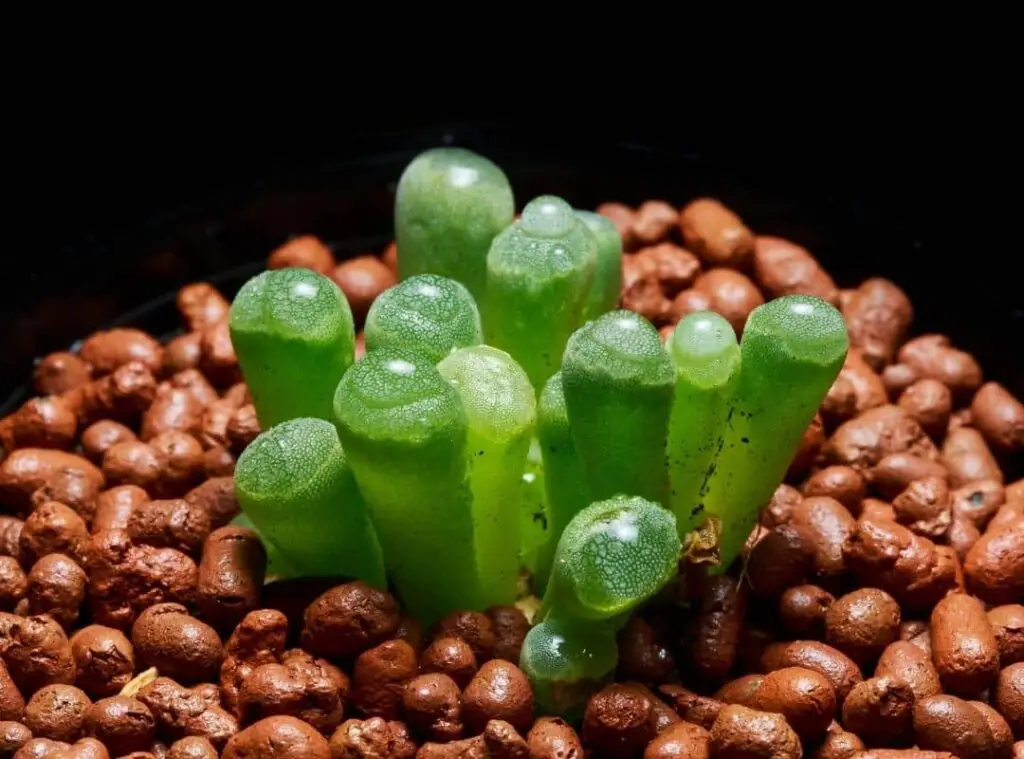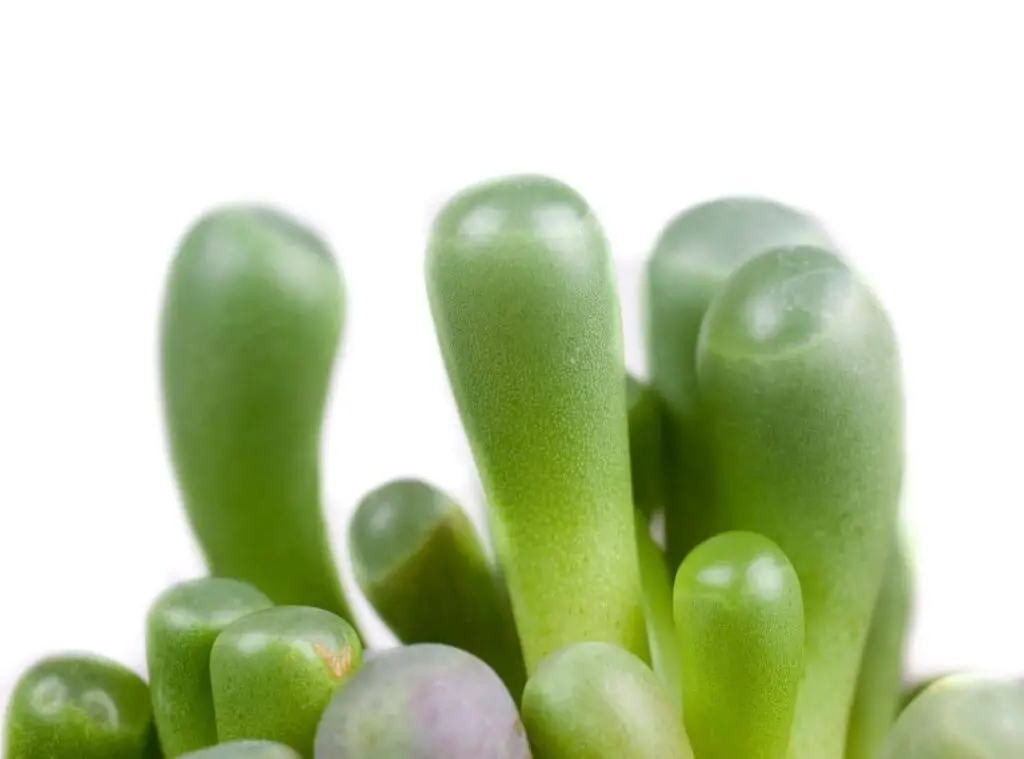You conduct Baby toes succulent propagation by their seeds, offsets and cuttings. Out of all these, offsets propagation method is the commonly used baby toes propagation method.
If you use the seeds propagation method, it will take a little longer to form roots. Further you cannot rely on the results as well.
Baby toes succulents are small succulents and they usually grow in clumps. Fenstraria rhopalophylla is the scientific name of these plants.

They are native plants to Namibia and to South Africa. You could call them as window leafed succulents as they carry tube shaped leaves tops which are transparent.
They are transparent as they do not have green pigment which allows the light to pass through.
Baby toes succulents produce flowers in white or yellow in spring and in fall. Baby toes succulents would be about 3 inches in height when they grow to their fullest.
So, from this article, I am going to cover the propagation methods of them and the after care tips you need to practice.
Can you propagate baby toes by cutting?
If you wish to propagate them by cuttings, you need to take off the whole branch first.
Further, it would be better if you can use mature plants which have a few branches for this purpose. Besides, spring would be the best season to do the propagation through cuttings.
- First obtain a stem cutting from a mature Baby toes plant.
- Next you can let those cuttings wither and develop callousness.
- In the meantime, arrange a substrate which has an excellent drainage and a good aeration.
- When the cuttings are dry and developed callousness you can plant them in the soil mix.
- However, when you plant them, ensure that you do not plant it too deep as unless it would lead to root rot.
- After that, you can water them periodically and expose them under indirect sunlight.
Do they produce seeds?
Baby toes produce seeds and you may use them for propagation as well.
If you wish to use the seeds propagation method, you need to start doing it in fall. You simply have to obtain the seeds and lay them in a succulent soil mix.
Next you need to cover the seeds with sand so that it will be even more favorable for the root formation process.
Further if you live in a colder environment, I suggest you use a grow lamp to supplement the light.
When you plant the seeds, you should cover the container with a plastic foil so that it will help to retain the moisture and the warmth within.
You need to keep a temperature around 66.2 degrees Fahrenheit ( 19 degrees Celsius) during this process.
Do they produce offsets
Baby toes do produce offsets.
However, if you propagate them by using the offsets, you need to remove the babies from the baby toes plants.
To do that you can gently remove them from the soil. Having said that, when you do that ensure that you do not damage the root system of the Baby toes plants.
Furthermore, you can simply cut off the offsets as well.
However, when you cut off the offsets, you need to do it with a clean, sharp knife so that it will not cause any infection of the plants.
When you obtain the offsets , leave them in a warmer place where they can wither and develop callous. After that you simply have to plant them in a well draining soil mix.
Can you root the Baby toes in water?
You can propagate Baby toes plants in water. The only difference here would be the growing medium you use for the propagation. Further It will be less messy compared to the soil propagation too.

How to treat after propagation
Sunlight requirement
Baby toes plants grow in bright sunlight when they grow in their natural habitats.
Hence when you place them outdoors, ensure that you are selecting a spot where they can gain full sunlight for about six hours preferably in the morning hours.
Further protect them from heavy rainfall as well as from scorching sunlight. Unless chances are that, it will scorch the plants.
Consider growing them near a bright sunny windowsill when you grow them as indoor plants. Further. If they still run short of sunlight,you could supplement the light requirement,by growing them under grow lights.
Unless it would make the plants etiolated.
Water requirement
You need to water these plants at the right time as it will be crucial in providing the right growing conditions for them.
If you spot their soil is dry when you touch it and if the leaves are wrinkled , you need to start watering them.
When watering you can simply pour water over the plant roots. Next see whether the excess water is draining from the draining holes of the pot as well.
Baby toes plants can thrive well even if you neglect watering them once or twice.That is simply because their leaves can conserve water in their leaves just like the rest of other succulents.
Having said that ,the plant’s growth would be benefited from occasional watering as it will allow them to fill their water storage and stay fresh and plump.
If you had over watered the plants, you would see how they started to split their leaves and start cracking. If you ever come across such a situation, you can keep it in a dry place where they can gain sufficient sunlight.
Temperature and humidity
Baby toes plants prefer to grow in USDA hardiness zones 10a-11b.
Further , these are desert dwelling succulents. Hence, they would prefer to grow in hot and dry weather conditions.
They will not withstand frost. As such if you are growing them outdoors where the plants will get colder weather conditions, I recommend growing them in containers which you can easily move in and out from home.
Simply you can bring the plants outdoors during spring and summer and shift them indoors when the temperature reduces.
Fertilizer requirement
Baby toes plants should not be overfed as they are quite sensitive for feed burns. They used to grow poor quality soil medium.
Hence , they do not require regular feeding. Having said that, a light feeding would be beneficial for the plant’s growth ideally in the beginning of the growing season.
Furthermore, the ideal fertilizer type should be a balanced fertilizer which has a low strength. Baby toes plants vigorous and firm growth would be benefitted from that. Suspend feeding them when they are dormant.

Pot
You need to select a slightly smaller pot than the plant as then it will make the whole plant look cuter.
Further it will help you to avoid over watering as well. Additionally ensure that it has a draining hole also which will allow you to avoid any excess water to remain in the pot.
Soil requirement
Do not grow these precious plants in regular potting soil or in any other potting substrate which has humus, loam, or peat moss.
They will retain moisture within the potting medium which is quite unhealthy for the plants. It would create root rots in the plants.
When there is excess moisture for too long, it will only make the plants more vulnerable for diseases such as root rot.
Best is to use a cactus soil mix or a succulent soil mix as they are fast draining and well aerating.
Alternatively, you can make a potting mix on your own too. You only need to mix equal parts of potting soil along with some gritty substance such as pumice, perlite, or coarse sand.
When you add these gritty substances, it will enhance the drain of the substrate and dry faster.
Conclusion
Before wrapping this up, Baby toes plants are yet another fascinating succulent which will perform well with minimum supervision from you.
Just like that, propagating them is also quite simple if you ensure that you are sticking to the aforesaid guidelines.Furthermore, it is vital that you practice the above after care treatments.
Baby toes plants would be handy to use for indoor gardening as well as for outdoor gardening especially due to the small size and due to the attractive shapes they have. They would be the highlight in your garden.
Read Next : Echeveria Setosa Propagation | 5 Effective Methods | Mistletoe Cactus Propagation | Effective Methods | Orchid Cactus Propagation | 4 Effective Methods |
